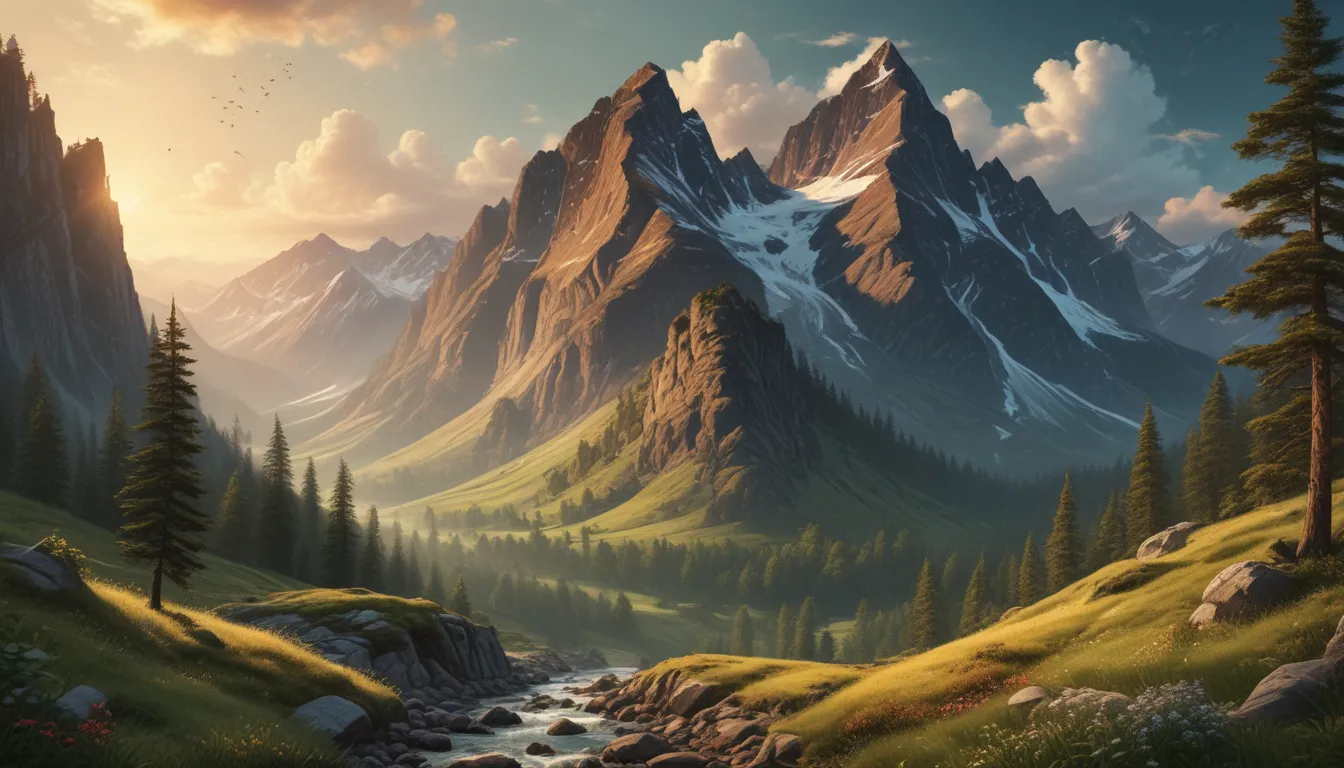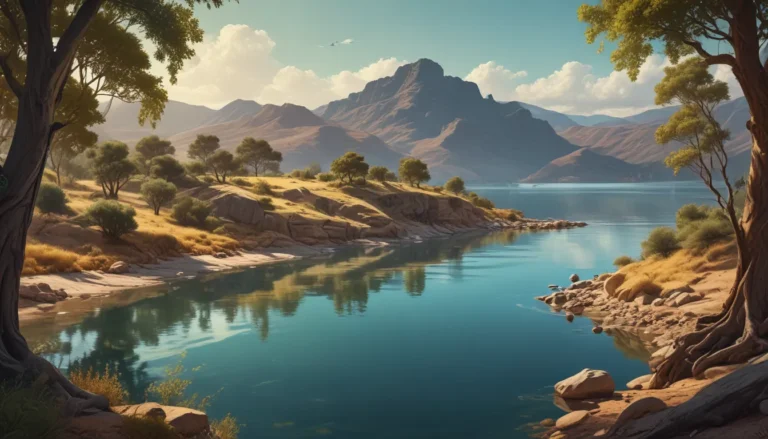The pictures we use in our articles might not show exactly what the words say. We choose these pictures to make you interested in reading more. The pictures work together with the words but don’t take their place. The words still tell you the important facts.
Mountains stand tall as majestic natural formations that captivate us with their breathtaking beauty and awe-inspiring grandeur. These geological wonders have shaped the Earth's landscape for millions of years, showcasing the incredible forces of nature at play. From the Himalayas to the Andes, mountains offer unique ecosystems and serve as habitats for a wide array of plant and animal species.
Discover the Diversity of Mountains
Mountains are diverse and fascinating, boasting the highest peak on Earth, Mount Everest, and the oldest range in North America, the Appalachian Mountains. They provide unique ecosystems and stunning landscapes for adventurers and nature enthusiasts. Mount Kilimanjaro offers a rare sight of snow and glaciers near the equator, while Mount Olympus in Greece was once believed to be the home of the gods. Mountains hold rich history, unique natural phenomena, and endless opportunities for exploration.
Unveiling Majestic Heights
-
Mount Everest: Standing at a staggering height of 29,029 feet (8,848 meters), Mount Everest reigns as the highest mountain in the world, enticing mountaineers with its daunting slopes.
-
Kilimanjaro: Rising 19,341 feet (5,895 meters) above the East African plains, Mount Kilimanjaro holds the title of the tallest free-standing mountain globally, offering a unique challenge for climbers.
-
Appalachian Mountains: Spanning over 2,000 miles (3,200 kilometers), the ancient and rugged Appalachian Mountains are estimated to be around 480 million years old, making them the oldest mountain range in North America.
Geological Marvels and Natural Splendor
-
Formation of the Himalayas: The Himalayan range, housing Mount Everest, was formed by the collision of the Indian and Eurasian tectonic plates over millions of years, creating these majestic peaks.
-
Andes Mountains: Stretching over 4,300 miles (7,000 kilometers), the Andes Mountains in South America claim the title of the longest continental mountain range, paralleling the Pacific coastline.
-
Rocky Mountains: Serving as the "Backbone of North America," the Rocky Mountains traverse Canada, the United States, and Mexico, playing a vital geological role in the continent.
-
Matterhorn: Rising to 14,692 feet (4,478 meters) in the Swiss Alps, the Matterhorn's pyramid-like shape has made it a symbol of Swiss mountaineering and a sought-after destination for climbers.
Thrilling Adventures and Natural Phenomena
-
Cascade Range: Home to numerous volcanoes, the Cascade Range spans from California through Oregon and Washington, featuring iconic peaks like Mount Rainier and Mount St. Helens.
-
Alps: Spanning several European countries, the Alps offer picturesque landscapes and abundant skiing opportunities, attracting outdoor enthusiasts year-round.
-
Ural Mountains: Serving as the boundary between Europe and Asia, the ancient Ural Mountains stretch from the Arctic Ocean to the Ural River.
-
Mount Fuji: Standing at 12,388 feet (3,776 meters), Mount Fuji is not only Japan's highest peak but also a cultural symbol deeply revered by the Japanese people.
Cultural Icons and Natural Wonders
-
Blue Mountains: Enveloped in a stunning blue haze, the Blue Mountains in Australia derive their name from the eucalyptus trees' sunlight scattering effect.
-
Mount Olympus: Revered in Greek mythology as the home of the Twelve Olympian gods, Mount Olympus held great significance and worship in ancient Greek culture.
-
Adirondack Mountains: Known for their vibrant fall foliage, the Adirondack Mountains in New York transform into a kaleidoscope of colors during autumn.
-
Dolomites: Designated as a UNESCO World Heritage site, the Dolomites in Italy captivate visitors with their dramatic peaks and picturesque landscapes.
Environmental Significance and Ecological Diversity
-
Great Dividing Range: Stretching over 2,300 miles (3,700 kilometers) along Australia's eastern coastline, the Great Dividing Range influences the country's weather patterns and ecosystems.
-
Himalayan Ecosystems: Hosting diverse habitats from tropical forests to alpine regions, the Himalayas support a wide range of ecosystems, serving as a biodiversity hotspot for various plant and animal species.
-
Mount Kilimanjaro's Anomaly: Mount Kilimanjaro is the only place in the world where snow and glaciers exist near the equator, showcasing a unique geographical phenomenon.
-
Mount Elbrus: As the highest peak in Europe, Mount Elbrus in the Caucasus Mountains stands at a towering height of 18,510 feet (5,642 meters), welcoming adventurers from around the globe.
-
Sierra Nevada National Parks: Home to iconic parks like Yosemite and Sequoia, the Sierra Nevada Mountains in California offer unparalleled natural beauty and recreational opportunities.
Preserve, Respect, and Explore
Mountains are not just geological wonders but symbols of inspiration and awe that connect us with the marvels of nature. Whether you're an intrepid explorer or a nature enthusiast, the allure of mountains beckons you to embark on a journey of discovery and appreciation. Remember to uphold sustainable tourism practices and leave no trace behind to preserve these fragile environments for future generations to enjoy. Mountains hold a special place in our hearts, enrich our lives, and play a vital role in maintaining our planet's ecological balance.
Answering Your Questions
Frequently Asked Questions
-
What is the highest mountain in the world? Mount Everest, towering at 29,032 feet (8,848 meters) in the Himalayas, claims the title of the highest mountain on Earth.
-
How are mountains formed? Mountains form through tectonic plate movements, volcanic activity, and erosion processes that shape the Earth's crust, creating the mountain ranges we see today.
-
Are mountains dangerous to climb? Mountain climbing can be hazardous due to unpredictable weather, steep terrain, and high altitudes. Proper training and equipment are crucial for a safe climbing experience.
-
How many mountain ranges exist worldwide? While the exact number is challenging to determine, it is estimated that there are approximately 1,000 major mountain ranges across the globe.
-
Can life survive in high-altitude mountain regions? Many animals and plants have adapted to thrive in high-altitude environments, with species like mountain goats and alpine flowers evolving to withstand extreme conditions.
A Commitment to Quality and Authenticity
Our dedication to delivering trustworthy and engaging content drives us to provide you with insightful and credible information. Each fact shared on our site is contributed by real users like you, offering diverse insights and knowledge. Our team of editors meticulously reviews each submission to uphold the highest standards of accuracy and reliability, ensuring that the facts we present are not only fascinating but also authentic. Trust in our commitment to quality as you explore and learn about the wonders of the world around us.






